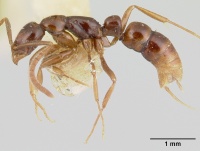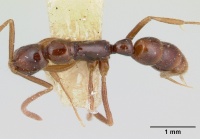Leptogenys guianensis
| Leptogenys guianensis | |
|---|---|

| |
| Scientific classification | |
| Kingdom: | Animalia |
| Phylum: | Arthropoda |
| Class: | Insecta |
| Order: | Hymenoptera |
| Family: | Formicidae |
| Subfamily: | Ponerinae |
| Tribe: | Ponerini |
| Genus: | Leptogenys |
| Species group: | pusilla |
| Species: | L. guianensis |
| Binomial name | |
| Leptogenys guianensis Wheeler, W.M., 1923 | |
Nothing is known about the biology of Leptogenys guianensis.
Identification
Lattke (2011) - A member of the pusilla species group. Head elongate, eyes flattened placed slightly anterad of lateral cephalic margin mid-distance; propodeal dorsal margin straight in lateral view, dorsal margin of propodeal tooth serrate in lateral view; node trapezoid in dorsal view, anterior and posterior margins parallel, anterior margin half the width of posterior margin.
Keys including this Species
Distribution
The range of Leptogenys guianensis is from French Guiana to northern Brazil.
Latitudinal Distribution Pattern
Latitudinal Range: 5.95° to -5.816667°.
| North Temperate |
North Subtropical |
Tropical | South Subtropical |
South Temperate |
- Source: AntMaps
Distribution based on Regional Taxon Lists
Neotropical Region: Brazil, French Guiana, Guyana (type locality).
Distribution based on AntMaps
Distribution based on AntWeb specimens
Check data from AntWeb
Countries Occupied
| Number of countries occupied by this species based on AntWiki Regional Taxon Lists. In general, fewer countries occupied indicates a narrower range, while more countries indicates a more widespread species. |

|
Estimated Abundance
| Relative abundance based on number of AntMaps records per species (this species within the purple bar). Fewer records (to the left) indicates a less abundant/encountered species while more records (to the right) indicates more abundant/encountered species. |

|
Biology
|
Castes
Queens and males are unknown.
Nomenclature
The following information is derived from Barry Bolton's Online Catalogue of the Ants of the World.
- guianensis. Leptogenys (Lobopelta) guianensis Wheeler, W.M. 1923d: 12, fig. 5 (w.) GUYANA. See also: Lattke, 2011: 192.
Unless otherwise noted the text for the remainder of this section is reported from the publication that includes the original description.
Description
Worker
Lattke (2011) - Metrics (n = 3) : HL 0.89 – 0.97; HW 0.58 – 0.62; ML 0.43 – 0.45; EL 0.12 – 0.14; SL 0.80 – 0.87; PW 0.52 – 0.55; WL 1.32 – 1.40; PH 0.52 – 0.53; PL 0.45 – 0.50; DPW 0.33–0.38 mm. CI 0.64–0.66; MI 0.70–0.74; OI 0.20 – 0.23; SI 1.37 – 1.41; LPI 1.07 – 1.19; DPI 0.74 – 0.81.
Head rectangular in full-face view, slightly wider anterad than posterad; posterior margin straight with vertexal carina visible most of length; lateral cephalic margin mostly broadly convex. Anterior clypeal margin evenly converges anterad to triangular median lobe, apex pointed to slightly blunt; clypeus longitudinally striate medially, laterally with transverse striae. Scape surpasses posterior cephalic border by less than one-fourth its length; densely punctulate; antennal segment III longer than either segments II or IV; segments II and IV each over half the length of III; segment III twice longer than wide. Cephalic dorsum mostly smooth and shining, with sparse piligerous punctulae. Mandibles shut tight against clypeus; elongate, parallel width, basal margin convex, external margin concave; dorsum with sparse punctulae and weak fine, parallel striae; basal angle obtuse, bluntly angular, apical tooth broad, basal margin with two stout hairs; PF: 4,4. Eye flat, situated laterally with slight medial tendency.
Mesosoma with broadly convex promesonotal margin in lateral view, posterior mesonotal margin drops into metanotal groove, dorsal propodeal margin mostly straight, curving onto declivity, propodeal tooth broadly triangular. Mesosoma mostly smooth and shining, with weak, oblique striae on ventral mesopleuron, propodeal spiracle round; mesometapleural suture well impressed, scrobiculate; propodeal spiracle elongate, posterolaterally facing. Mesonotum wider than long in dorsal view, anterior margin curved, posterior margin straight, metanotal groove scrobiculate; propodeal declivity with transverse striae. Petiole subquadrate in lateral view, anterior margin almost half length of posterior margin, dorsal margin mostly sloped with rounded apex, node highest posterad of mid-length; posterior margin mostly straight. Node trapezoid in dorsal view, anterior and posterior margins parallel, anterior margin half the width of posterior margin, gaster smooth and shining with sparse piligerous punctulae. Procoxa smooth and shining laterally, body with sparse standing pilosity, no appressed pilosity. Mandible, clypeus, antennae, and legs light brown; head, mesosoma, petiole and gaster ferruginous brown; apex of protarsus with slender seta; dorsal surface of metacoxa with low posterior lobe. Constriction between abdominal segments III and IV well marked.
Type Material
Syntype workers: Guiana (= British Guiana), Dunoon, 2.viii.1914, Cat. No. 1 – 2, 20508 (F.M. Gaige) (Museum of Comparative Zoology) [examined].
The syntypes are two point-mounted workers on the same pin: MCZ Cotype 1 – 2, 20508. Wheeler’s (1923) description is quite detailed and I agree with all save the extension of the scape beyond the posterior cephalic border, which is one-third according to him. The type series specimens are paler in color than the specimens from Suriname or Brazil.
References
- Albuquerque, E., Prado, L., Andrade-Silva, J., Siqueira, E., Sampaio, K., Alves, D., Brandão, C., Andrade, P., Feitosa, R., Koch, E., Delabie, J., Fernandes, I., Baccaro, F., Souza, J., Almeida, R., Silva, R. 2021. Ants of the State of Pará, Brazil: a historical and comprehensive dataset of a key biodiversity hotspot in the Amazon Basin. Zootaxa 5001, 1–83 (doi:10.11646/zootaxa.5001.1.1).
- Lattke, J.E. 2011. Revision of the New World species of the genus Leptogenys Roger (Insecta: Hymenoptera: Formicidae: Ponerinae). Arthropod Systematics & Phylogeny. 69:127-264.
- Wheeler, W. M. 1923e. The occurrence of winged females in the ant genus Leptogenys Roger, with descriptions of new species. American Museum Novitates 90: 1-16 (page 12, fig. 5 worker described
References based on Global Ant Biodiversity Informatics
- Fernández F., and T. M. Arias-Penna. 2008. Las hormigas cazadoras en la región Neotropical. Pp. 3-39 in: Jiménez, E.; Fernández, F.; Arias, T.M.; Lozano-Zambrano, F. H. (eds.) 2008. Sistemática, biogeografía y conservación de las hormigas cazadoras de Colombia. Bogotá: Instituto de Investigación de Recursos Biológicos Alexander von Humboldt, xiv + 609 pp.
- Fernández, F. and S. Sendoya. 2004. Lista de las hormigas neotropicales. Biota Colombiana Volume 5, Number 1.
- Kempf, W.W. 1972. Catalago abreviado das formigas da regiao Neotropical (Hym. Formicidae) Studia Entomologica 15(1-4).
- Lattke J. E. 2011. Revision of the New World species of the genus Leptogenys Roger (Insecta: Hymenoptera: Formicidae: Ponerinae). Arthropod Systematics and Phylogeny 69: 127-264
- Pires de Prado L., R. M. Feitosa, S. Pinzon Triana, J. A. Munoz Gutierrez, G. X. Rousseau, R. Alves Silva, G. M. Siqueira, C. L. Caldas dos Santos, F. Veras Silva, T. Sanches Ranzani da Silva, A. Casadei-Ferreira, R. Rosa da Silva, and J. Andrade-Silva. 2019. An overview of the ant fauna (Hymenoptera: Formicidae) of the state of Maranhao, Brazil. Pap. Avulsos Zool. 59: e20195938.
- Wheeler W. M. 1923. The occurrence of winged females in the ant genus Leptogenys Roger, with descriptions of new species. American Museum Novitates 90: 1-16.

